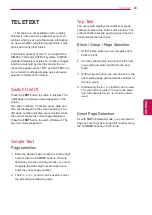
88
ENG
ENGLISH
MAKING CONNECTIONS
Connecting to a PC
HDMI Connection, DVI to HDMI Connection or RGB Connection
Choose method A, B, or C to make connection.
Method A: HDMI Connection
(*Not Provided)
Choose any HDMI input port to connect.
It does not matter which port you use.
PC
y
y
Avoid keeping a fixed image on the set’s screen for prolonged periods of time. The fixed image may become
permanently imprinted on the screen; use a screen saver when possible.
y
y
There may be interference relating to resolution, vertical pattern, contrast or brightness in PC mode. Change the
PC mode to another resolution or change the refresh rate to another rate or adjust the brightness and contrast
on the menu until the picture is clear. If the refresh rate of the PC graphic card can not be changed, change the
PC graphic card or consult the manufacturer of the PC graphic card.
y
y
The synchronization input waveform for Horizontal and Vertical frequencies are separate.
y
y
We recommend using 1920x1080 for the PC mode, this should provide the best picture quality.
y
y
Connect the signal cable from the monitor output port of the PC to the RGB (PC) port of the TV or the signal
cable from the HDMI output port of the PC to the HDMI IN (or HDMI/DVI IN) port on the TV.
y
y
Connect the audio cable from the PC to the Audio input on the TV. (Audio cables are not included with the TV).
y
y
If using a sound card, adjust PC sound as required.
y
y
If the graphic card on the PC does not output analogue and digital RGB simultaneously, connect only one of
either RGB or HDMI IN (or HDMI/DVI IN) to display the PC output on the TV.
y
y
DOS mode may not work depending on the video card if you use an HDMI to DVI cable.
y
y
If you use too long an RGB-PC cable, there may be interference on the screen. We recommend using under
5m of cable. This provides the best picture quality.
NOTE
Summary of Contents for 0PA5500-ZB
Page 3: ...3 ENG ENGLISH LICENSES ...
Page 135: ......
















































